Endoparasitic Gall Mites: Two New Novophytoptus Species (Eriophyoidea, Phytoptidae) from Southern African Sedges (Cyperaceae, Carex) and New Hypotheses on the Phylogeny of Novophytoptines †
Abstract
1. Introduction
2. Material and Methods
3. Taxonomy
4. Molecular Phylogenetic Analyses
5. Discussion
Supplementary Materials
Author Contributions
Funding
Institutional Review Board Statement
Data Availability Statement
Acknowledgments
Conflicts of Interest
References
- Oldfield, G.N. Diversity and host plant specificity. In Eriophyoid Mites: Their Biology, Natural Enemies and Control. World Crop Pests 6; Lindquist, E.E., Sabelis, M.W., Bruin, J., Eds.; Elsevier Science Publishing: Amsterdam, The Netherlands, 1996; Volume 6, pp. 199–216. [Google Scholar] [CrossRef]
- Amrine, J.W., Jr.; Stasny, T.A.H.; Flechtmann, C.H.W. Revised Keys to the World Genera of the Eriophyoidea (Acari: Prostigmata); Indira Publishing House: West Bloomfield, MI, USA, 2003; 244p. [Google Scholar]
- Sullivan, G.; Ozman-Sullivan, S.K. Alarming evidence of widespread mite extinctions in the shadows of plant, insect and vertebrate extinctions. Austral Ecol. 2021, 46, 163–176. [Google Scholar] [CrossRef]
- Lindquist, E.E. External anatomy and notation of structures. In Eriophyoid Mites: Their Biology, Natural Enemies and Control. World Crop Pests 6; Lindquist, E.E., Sabelis, M.W., Bruin, J., Eds.; Elsevier Science Publishing: Amsterdam, The Netherlands, 1996; Volume 6, pp. 3–31. [Google Scholar] [CrossRef]
- Skoracka, A.; Smith, L.; Oldfield, G.; Cristofaro, M.; Amrine, J.W. Host-plant specificity and specialization in eriophyoid mites and their importance for the use of eriophyoid mites as biocontrol agents of weeds. Exp. Appl. Acarol. 2010, 51, 93–113. [Google Scholar] [CrossRef]
- Paponova, S.S.; Chetverikov, P.E.; Pautov, A.A.; Yakovleva, O.V.; Zukoff, S.N.; Vishnyakov, A.E.; Sukhareva, S.I.; Krylova, E.G.; Dodueva, I.E.; Lutova, L.A. Gall mite Fragariocoptes setiger (Eriophyoidea) changes leaf developmental program and regulates gene expression in the leaf tissues of Fragaria viridis (Rosaceae). Ann. Appl. Biol. 2018, 172, 33–46. [Google Scholar] [CrossRef]
- de Lillo, E.; Pozzebon, A.; Valenzano, D.; Duso, C. An intimate relationship between eriophyoid mites and their host plants–A review. Front. Plant Sci. 2018, 9, 1786. [Google Scholar] [CrossRef] [PubMed]
- Poulin, R. Evolutionary Ecology of Parasites, 2nd ed.; Princeton University Press: Princeton, NJ, USA, 2011; 360p. [Google Scholar] [CrossRef]
- Dowling, A. The evolution of parasitism and host associations in mites. In Parasite Diversity and Diversification: Evolutionary Ecology Meets Phylogenetics; Morand, S., Krasnov, B., Littlewood, D., Eds.; Cambridge University Press: Cambridge, UK, 2015; pp. 265–288. [Google Scholar] [CrossRef]
- Krantz, G.W. Habit and Habitats. In A manual of Acarology, 3rd ed.; Krantz, G.W., Walter, D.E., Eds.; Texas Tech University Press: Lubbock, TX, USA, 2009; pp. 64–82. [Google Scholar]
- Nuzzaci, G.; Alberti, G. Internal anatomy and physiology. In Eriophyoid Mites: Their Biology, Natural Enemies and Control. World Crop Pests 6; Lindquist, E.E., Sabelis, M.W., Bruin, J., Eds.; Elsevier Science Publishing: Amsterdam, The Netherlands, 1996; Volume 6, pp. 101–150. [Google Scholar] [CrossRef]
- Sidorchuk, E.A.; Schmidt, A.R.; Ragazzi, E.; Roghi, G.; Lindquist, E.E. Plant-feeding mite diversity in Triassic amber (Acari: Tetrapodili). J. Syst. Palaeontol. 2014, 13, 129–151. [Google Scholar] [CrossRef]
- Bolton, S.J.; Bauchan, G.R.; Chetverikov, P.E.; Ochoa, R.; Klompen, H. A rudimentary sheath for the smallest of “biting” chelicerae: The mouthparts of Cunliffea (Nematalycidae) and a new hypothesis on the origin of the stylet sheath of Eriophyoidea (Acariformes). Int. J. Acarol. 2018, 44, 374–381. [Google Scholar] [CrossRef]
- Bolton, S.J.; Chetverikov, P.E.; Klompen, H. Morphological support for a clade comprising two vermiform mite lineages: Eriophyoidea (Acariformes) and Nematalycidae (Acariformes). Syst. Appl. Acarol. 2017, 22, 1096–1131. [Google Scholar] [CrossRef]
- Klimov, P.B.; Chetverikov, P.E.; Dodueva, I.E.; Vishnyakov, A.E.; Bolton, S.J.; Paponova, S.S.; Lutova, L.A.; Tolstikov, A.V. Symbiotic bacteria of the gall-inducing mite Fragariocoptes setiger (Eriophyoidea) and phylogenomic resolution of the eriophyoid position among Acari. Sci. Rep. UK 2022, 12, 3811. [Google Scholar] [CrossRef]
- Haupt, J.; Coineau, Y. Ultrastructure and functional morphology of a nematalycid mite (Acari: Actinotrichida: Endostigmata: Nematalycidae): Adaptations to mesopsammal life. Acta Zool. 1999, 80, 97–112. [Google Scholar] [CrossRef]
- Chetverikov, P.E. Hidden diversity of endoparasitic eriophyoid mites: Two new Novophytoptus Roivainen, 1947 (Acari: Eriophyoidea: Phytoptidae) species from the parenchymatous tissues of rushes (Juncaceae). Zootaxa 2015, 4006, 481–505. [Google Scholar] [CrossRef]
- Chetverikov, P.E.; Amrine, J.; Bauchan, G.; Ochoa, R.; Sukhareva, S.I.; Vishnyakov, A.E. Supplementary description of Novophytoptus stipae Keifer 1962 (Acariformes, Eriophyoidea) with LT-SEM observation on mites from putatively conspecific populations: Cryptic speciation or polyphagy of novophytoptines on phylogenetically remote hosts? Syst. Appl. Acarol. 2017, 22, 253–270. [Google Scholar] [CrossRef]
- Bouchenak-Khelladi, Y.; Muasya, A.M.; Linder, H.P. A revised evolutionary history of Poales: Origins and diversification. Bot. J. Linn. Soc. 2014, 175, 4–16. [Google Scholar] [CrossRef]
- Flechtmann, C.H. Eriophyid mites (Acari: Eriophyidae) from Brazilian sedges (Cyperaceae). Int. J. Acarol. 2004, 30, 157–164. [Google Scholar] [CrossRef]
- Amrine, J.W., Jr.; Manson, D.C.M. Preparation, mounting and descriptive study of eriophyoid mites. In Eriophyoid Mites: Their Biology, Natural Enemies and Control. World Crop Pests 6; Lindquist, E.E., Sabelis, M.W., Bruin, J., Eds.; Elsevier Science Publishing: Amsterdam, The Netherlands, 1996; Volume 6, pp. 383–396. [Google Scholar] [CrossRef]
- Chetverikov, P.E. Video projector: A digital replacement for camera lucida for drawing mites and other microscopic objects. Syst. Appl. Acarol. 2016, 21, 1278–1280. [Google Scholar] [CrossRef]
- Gehrke, B. Synopsis of Carex (Cyperaceae) from sub-Saharan Africa and Madagascar. Bot. J. Linn. Soc. 2011, 166, 51–99. [Google Scholar] [CrossRef]
- Klimov, P.B.; OConnor, B.M.; Chetverikov, P.E.; Bolton, S.J.; Pepato, A.R.; Mortazavi, A.L.; Tolstikov, A.V.; Bauchan, G.R.; Ochoa, R. Comprehensive phylogeny of acariform mites (Acariformes) provides insights on the origin of the four-legged mites (Eriophyoidea), a long branch. Mol. Phylogenet. Evol. 2018, 119, 105–117. [Google Scholar] [CrossRef]
- Katoh, K.; Misawa, K.; Kuma, K.; Miyata, T. MAFFT: A novel method for rapid multiple sequence alignment based on fast Fourier transformation. Nucleic Acids Res. 2002, 30, 3059–3066. [Google Scholar] [CrossRef] [PubMed]
- Katoh, K.; Rozewicki, J.; Yamada, K.D. MAFFT online service: Multiple sequence alignment, interactive sequence choice and visualization. Brief. Bioinform. 2017, 20, 1160–1166. [Google Scholar] [CrossRef]
- Kumar, S.; Stecher, G.; Tamura, K. MEGA7: Molecular evolutionary genetics analysis version 7.0 for bigger datasets. Mol. Biol. Evol. 2017, 33, 1870–1874. [Google Scholar] [CrossRef]
- Minh, B.Q.; Schmidt, H.A.; Chernomor, O.; Schrempf, D.; Woodhams, M.D.; von Haeseler, A.; Lanfear, R. IQ-TREE 2: New Models and Efficient Methods for Phylogenetic Inference in the Genomic Era. Mol. Biol. Evol. 2020, 37, 1530–1534. [Google Scholar] [CrossRef] [PubMed]
- Kalyaanamoorthy, S.; Minh, B.Q.; Wong, T.K.F.; von Haeseler, A.; Jermiin, L.S. ModelFinder: Fast model selection for accurate phylogenetic estimates. Nat. Methods 2017, 14, 587–589. [Google Scholar] [CrossRef] [PubMed]
- Skoracka, A.; Boczek, J. Novophytoptus glyceriae sp. n. and N. ammophilae sp. n., the new species of eriophyoid mites (Acari: Eriophyoidea) from grasses. Acarina 2000, 8, 95–101. [Google Scholar]
- Roivainen, H. Eriophyid news from Finland. Entomol. Fenn. 1947, 3, 1–51. [Google Scholar]
- Chetverikov, P.E.; Sukhareva, S.I. Supplementary descriptions and biological notes on eriophyid mites (Acari: Eriophyidae) of the genus Novophytoptus Roivainen, 1947. Acarina 2007, 15, 261–268. [Google Scholar]
- Petanović, R.; Chetverikov, P.; Smiljanić, D. Eriophyoid mites (Acari: Eriophyoidea) from sedges (Carex spp., Cyperaceae) in Serbia. Acta Entomol. Serbica 2007, 12, 107–113. [Google Scholar]
- Skoracka, A.; Dabert, M. The cereal rust mite Abacarus hystrix (Acari: Eriophyoidea) is a complex of species: Evidence from mitochondrial and nuclear DNA sequences. Bull. Entomol. Res. 2010, 100, 263–272. [Google Scholar] [CrossRef] [PubMed]
- Skoracka, A.; Kuczyński, L.; de Mendonça, R.S.; Dabert, M.; Szydło, W.; Knihinicki, D.; Truol, G.; Navia, D. Cryptic species within the wheat curl mite Aceria tosichella (Keifer)(Acari: Eriophyoidea), revealed by mitochondrial, nuclear and morphometric data. Invertebr. Syst. 2012, 26, 417–433. [Google Scholar] [CrossRef]
- Smith, I.M. A new species of eriophyoid mite with eye-like structures, and remarks on the genus Phytoptus (Acari: Prostigmata: Phytoptidae). Can. Entomol. 1977, 109, 1097–1102. [Google Scholar] [CrossRef]
- Flechtmann, C.H.; Arana, M.; Ciarrocchi, F.; Chetverikov, P.E.; Amrine, J.W., Jr. Rediscovery and redescription of two eriophyid mites (Acari, Prostigmata, Eriophyidae) from Baccharis salicifolia (Asteraceae), from Argentina with remarks on the eriophyoid coverflap base. Acarologia 2015, 55, 387–396. [Google Scholar] [CrossRef]
- Lebrun, J.-P.; Stork, A.L. Tropical African Flowering Plants: Ecology and Distribution; Cyperaceae; Éditions des Conservatoire et Jardin Botaniques: Genève, Switzerland, 2020; Volume 11, 368p. [Google Scholar]
- Herman, P.P.J.; Retief, E. Plants of thenorthern provinces of South Africa: Keys and diagnostic characters. Strelitzia 1997, 6, 1–681. [Google Scholar]
- Retief, E.; Meyer, N.L. Cyperaceae. In Plants of the Free State: Inventory and Identification Guide; Retief, E., Meyer, N.L., Eds.; Strelitzia, South African National Biodiversity Institute: Pretoria, South Africa, 2017; Volume 38, pp. 875–904. [Google Scholar]
- Global Plants. Available online: http://plants.jstor.org (accessed on 22 November 2022).
- Chetverikov, P.E.; Craemer, C.; Cvrković, T.; Klimov, P.B.; Petanović, R.U.; Romanovich, A.E.; Sukhareva, S.I.; Zukoff, S.N.; Bolton, S.; Amrine, J. Molecular phylogeny of the phytoparasitic mite family Phytoptidae (Acariformes: Eriophyoidea) identified the female genitalic anatomy as a major macroevolutionary factor and revealed multiple origins of gall induction. Exp. Appl. Acarol. 2021, 83, 31–68. [Google Scholar] [CrossRef]
- Lindquist, E.E.; Amrine, J.W., Jr. Systematics, diagnoses for major taxa, and keys to families and genera with species on plants of economic importance. In Eriophyoid Mites: Their Biology, Natural Enemies and Control. World Crop Pests 6; Lindquist, E.E., Sabelis, M.W., Bruin, J., Eds.; Elsevier Science Publishing: Amsterdam, The Netherlands, 1996; Volume 6, pp. 33–87. [Google Scholar] [CrossRef]
- Guo, J.F.; Li, H.S.; Wang, B.; Xue, X.F.; Hong, X.Y. DNA barcoding reveals the protogyne and deutogyne of Tegolophus celtis sp. nov. (Acari: Eriophyidae). Exp. Appl. Acarol. 2015, 67, 393–410. [Google Scholar] [CrossRef]
- Petanović, R. Towards an integrative approach to taxonomy of Eriophyoidea (Acari, Prostigmata)-An overview. Ecol. Montenegrina 2016, 7, 580–599. [Google Scholar] [CrossRef]
- Druciarek, T.; Lewandowski, M.; Tzanetakis, I. A new, sensitive and efficient method for taxonomic placement in the Eriophyoidea and virus detection in individual eriophyoids. Exp. Appl. Acarol. 2019, 78, 247–261. [Google Scholar] [CrossRef]
- Chetverikov, P.E.; Klimov, P.B.; He, Q. Vertical transmission and seasonal dimorphism of eriophyoid mites (Acariformes, Eriophyoidea) parasitic on the Norway maple: A case study. Royal Soc. Open Sci. 2022, 9, 220820. [Google Scholar] [CrossRef]
- Skoracka, A.; Magalhaes, S.; Rector, B.G.; Kuczyński, L. Cryptic speciation in the Acari: A function of species lifestyles or our ability to separate species? Exp. Appl. Acarol. 2015, 67, 165–182. [Google Scholar] [CrossRef] [PubMed]
- Druciarek, T.; Lewandowski, M.; Tzanetakis, I. Molecular phylogeny of Phyllocoptes associated with roses discloses the presence of a new species. Infect. Genet. Evol. 2021, 95, 105051. [Google Scholar] [CrossRef] [PubMed]
- Cvrković, T.; Chetverikov, P.; Vidović, B.; Petanović, R. Cryptic speciation within Phytoptus avellanae s.l. (Eriophyoidea: Phytoptidae) revealed by molecular data and observations on molting Tegonotus-like nymphs. Exp. Appl. Acarol. 2016, 68, 83–96. [Google Scholar] [CrossRef]
- Saccaggi, D.L.; Maboeei, P.; Powell, C.; Ngubane-Ndhlovu, N.P.; Allsopp, E.; Wesley-Smith, J.; van Asch, B. Towards Solving the “Colomerus vitis Conundrum”: Genetic Evidence Reveals a Complex of Highly Diverged Groups with Little Morphological Differentiation. Diversity 2022, 14, 342. [Google Scholar] [CrossRef]
- Larose, C.; Schwander, T. Nematode endoparasites do not codiversify with their stick insect hosts. Ecol. Evol. 2016, 6, 5446–5458. [Google Scholar] [CrossRef] [PubMed]
- Sabelis, M.W.; Bruin, J. Evolutionary ecology: Life history patterns, food plant choice and dispersal. In Eriophyoid Mites: Their Biology, Natural Enemies and Control. World Crop Pests 6; Lindquist, E.E., Sabelis, M.W., Bruin, J., Eds.; Elsevier Science Publishing: Amsterdam, The Netherlands, 1996; Volume 6, pp. 329–366. [Google Scholar]
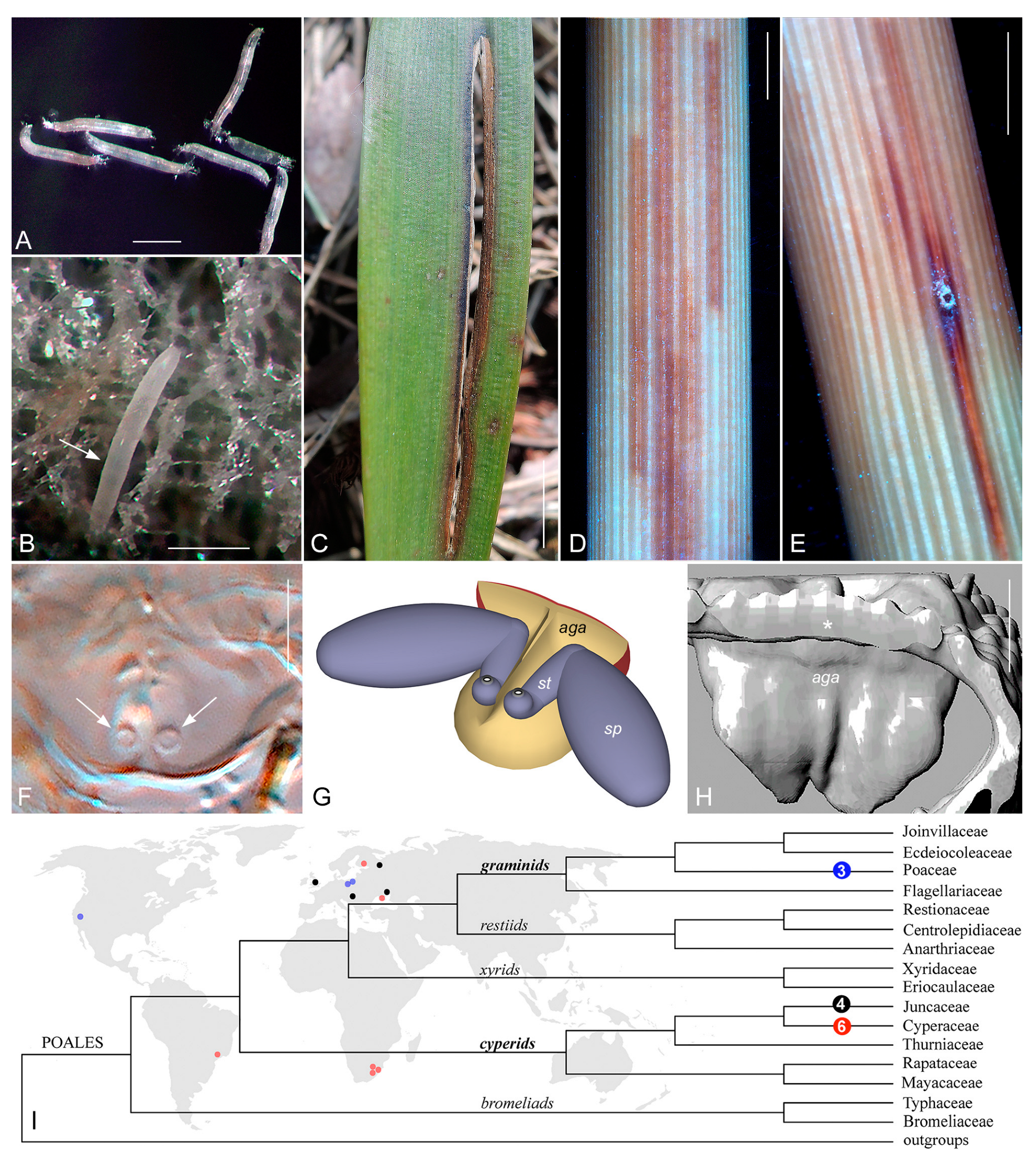
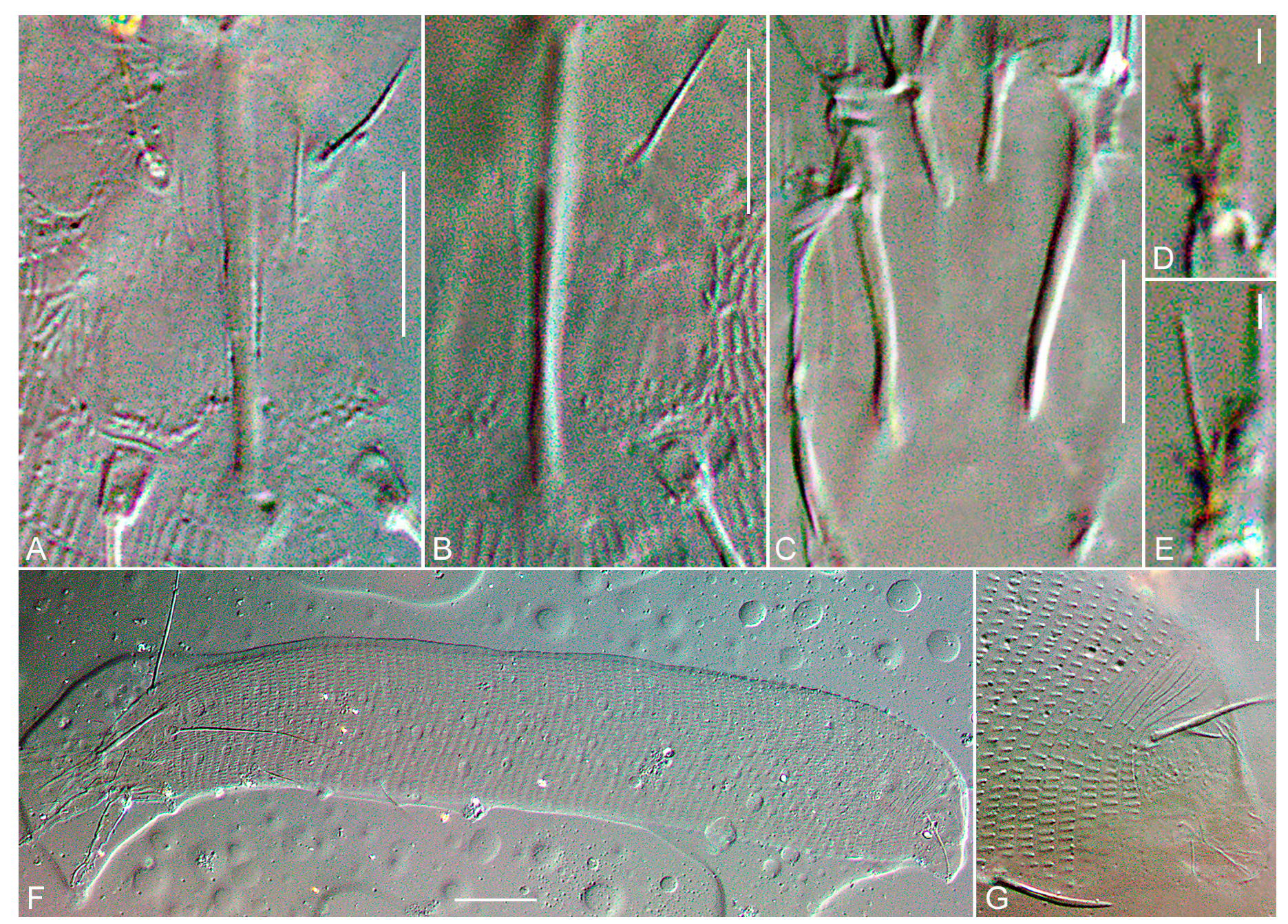
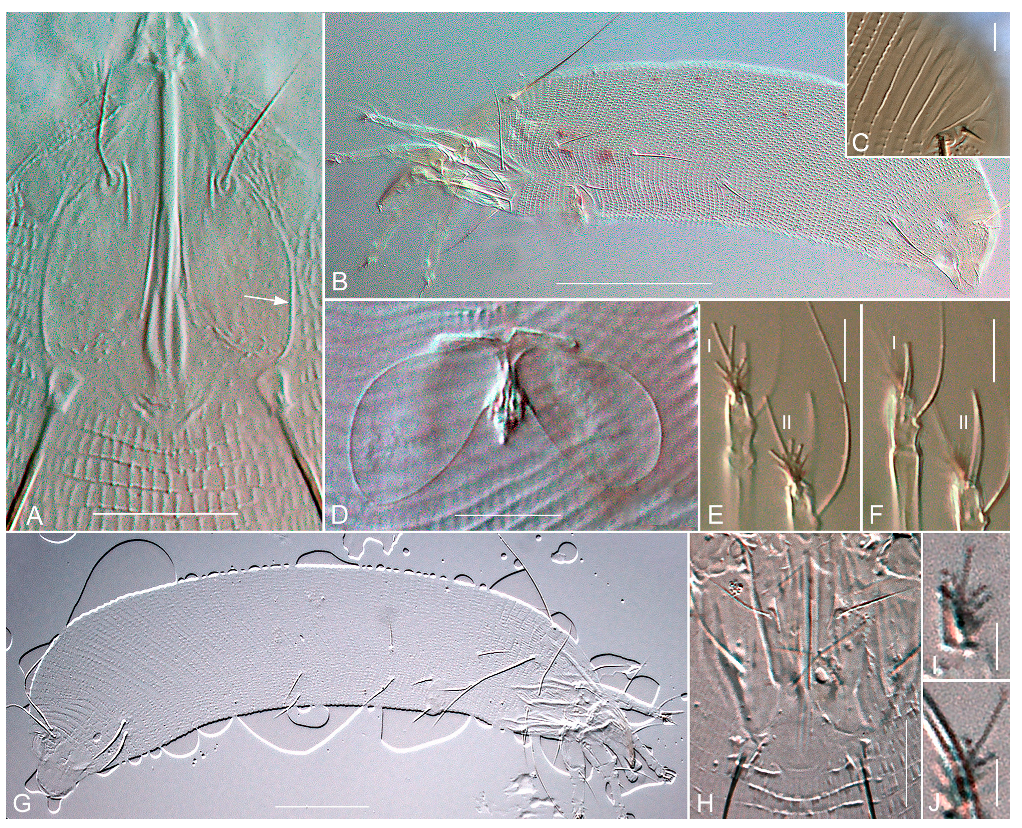
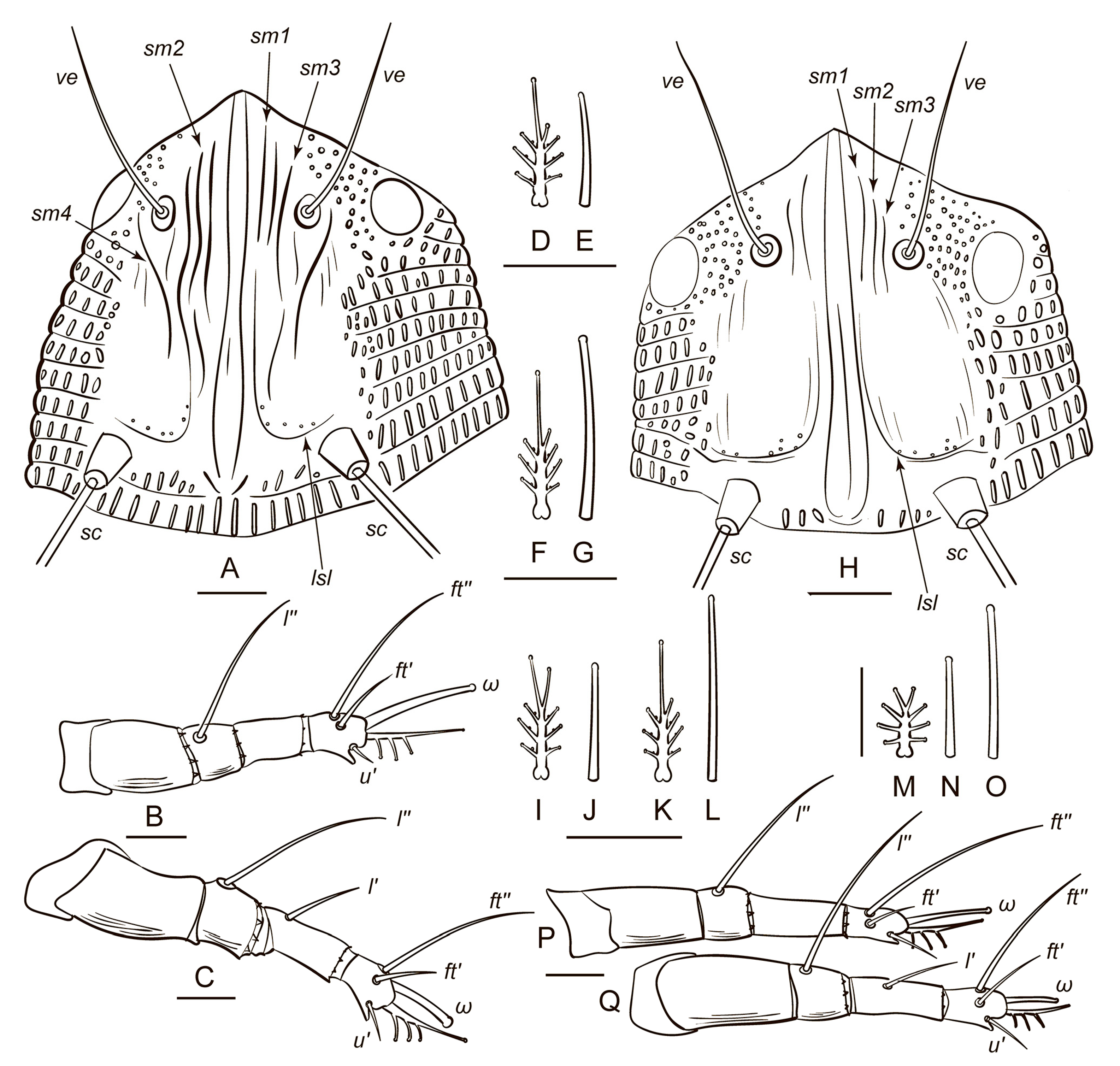
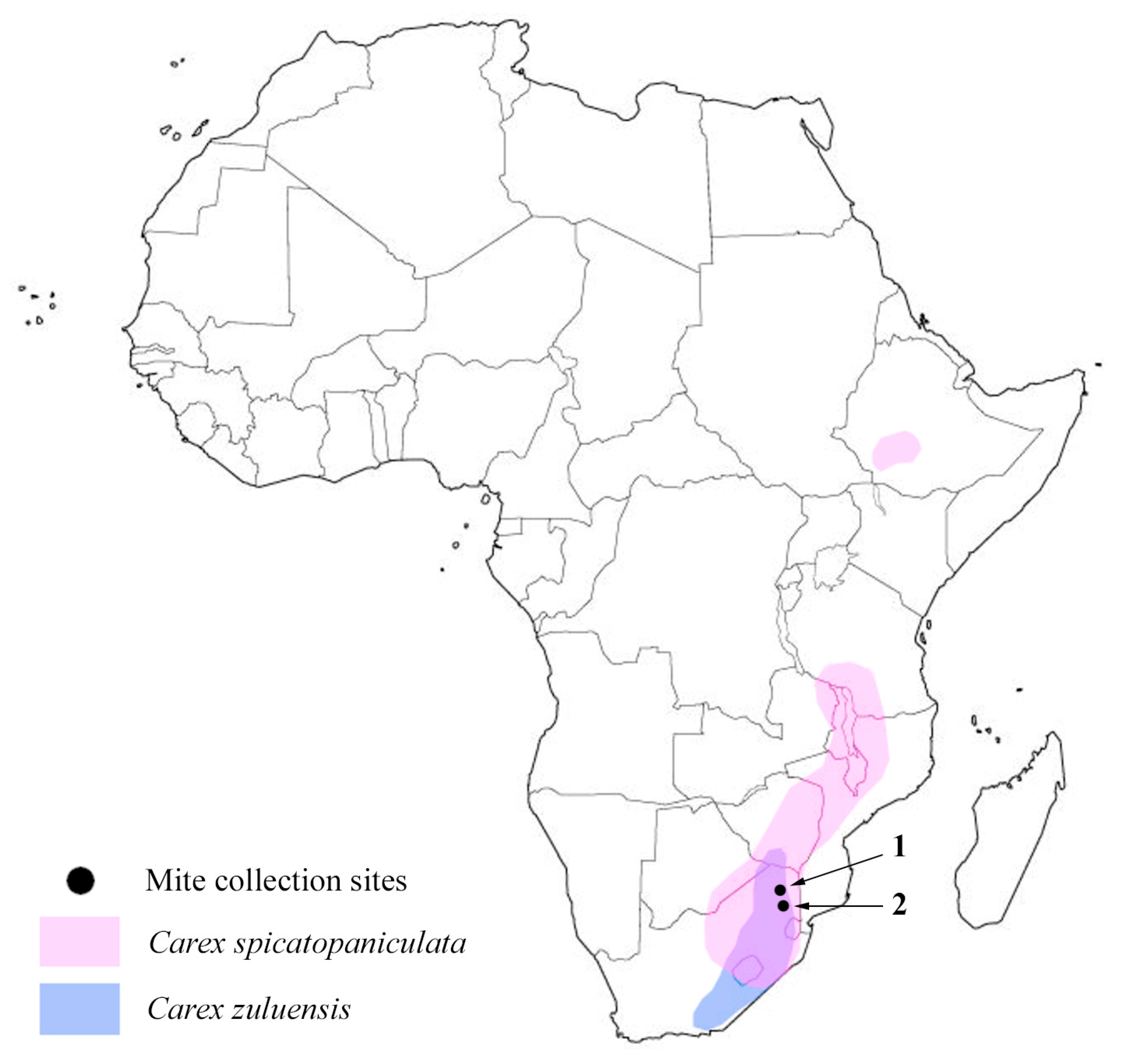
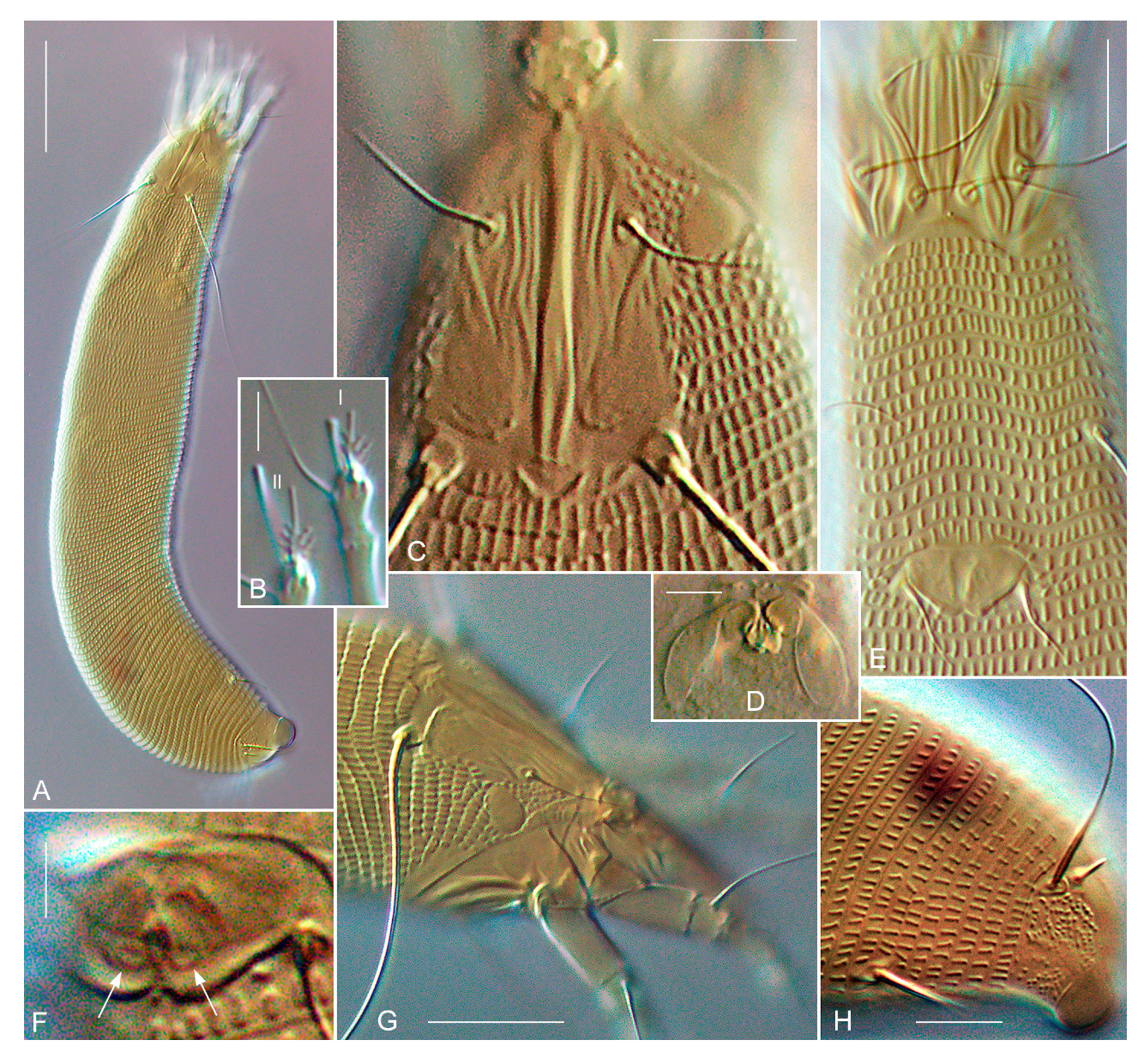
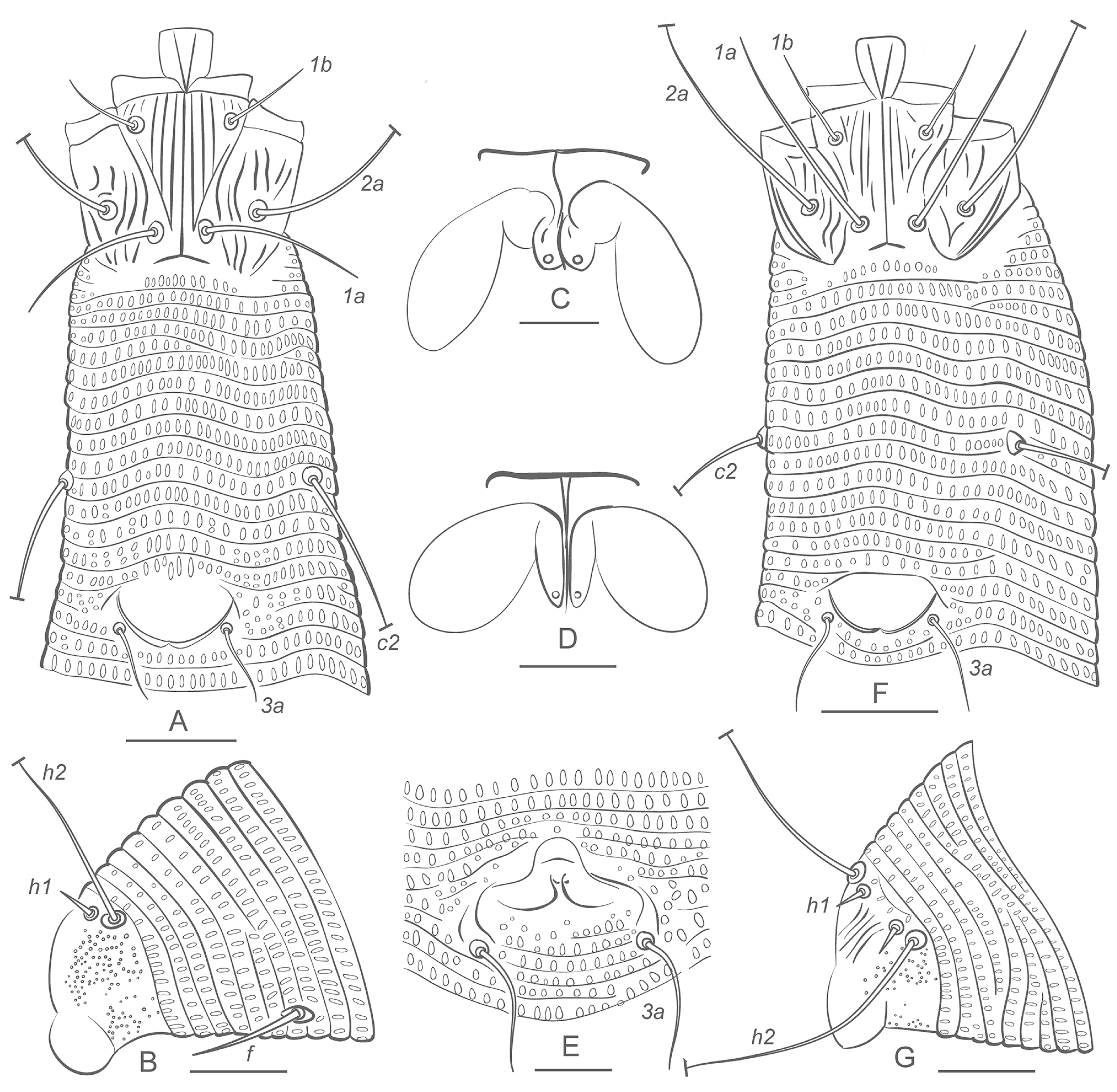
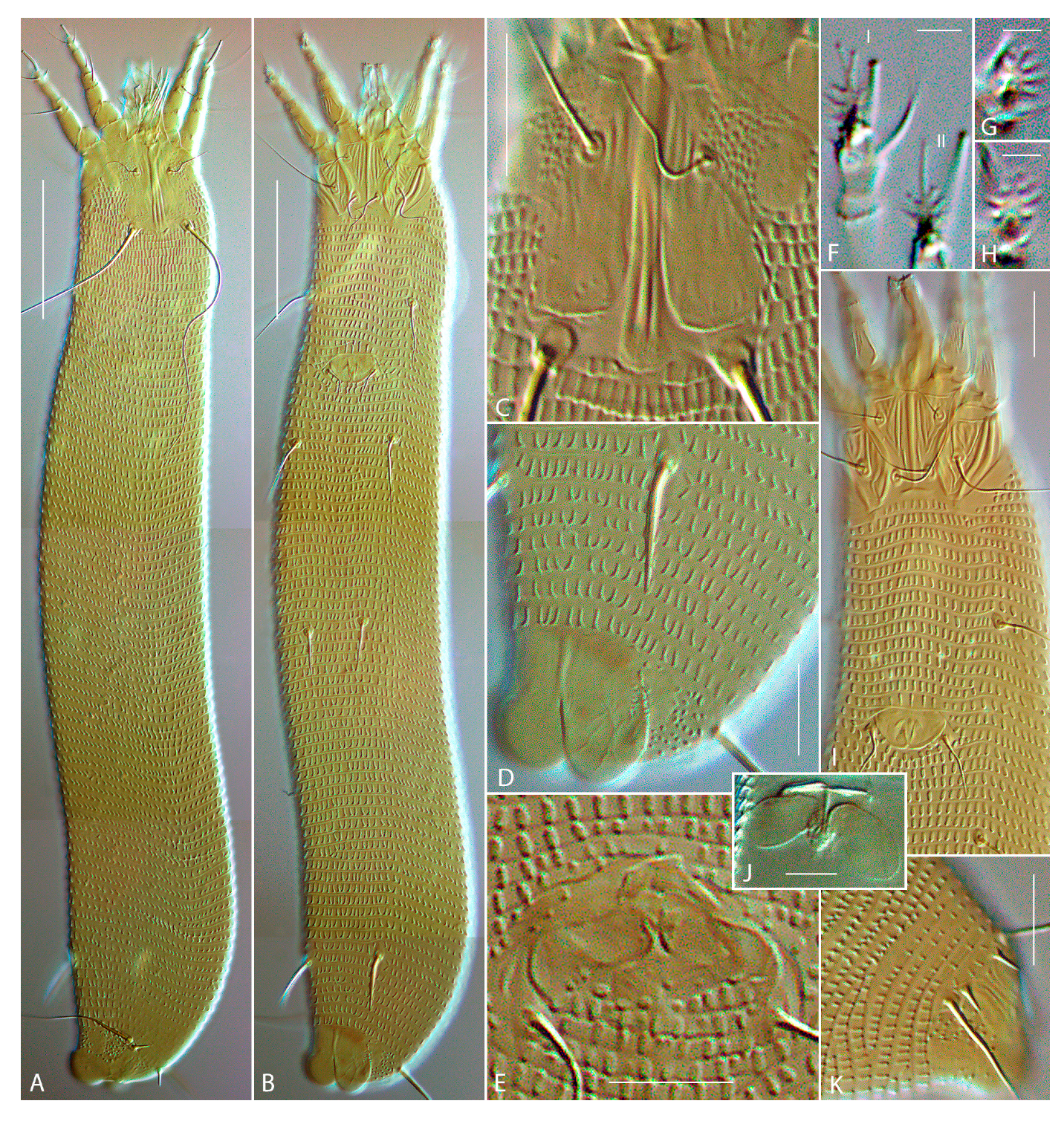

Disclaimer/Publisher’s Note: The statements, opinions and data contained in all publications are solely those of the individual author(s) and contributor(s) and not of MDPI and/or the editor(s). MDPI and/or the editor(s) disclaim responsibility for any injury to people or property resulting from any ideas, methods, instructions or products referred to in the content. |
© 2023 by the authors. Licensee MDPI, Basel, Switzerland. This article is an open access article distributed under the terms and conditions of the Creative Commons Attribution (CC BY) license (https://creativecommons.org/licenses/by/4.0/).
Share and Cite
Chetverikov, P.E.; Craemer, C.; Gankevich, V.D.; Kremenetskaya, M.V.; Kuzmin, I.V.; Zhuk, A.S. Endoparasitic Gall Mites: Two New Novophytoptus Species (Eriophyoidea, Phytoptidae) from Southern African Sedges (Cyperaceae, Carex) and New Hypotheses on the Phylogeny of Novophytoptines. Diversity 2023, 15, 416. https://doi.org/10.3390/d15030416
Chetverikov PE, Craemer C, Gankevich VD, Kremenetskaya MV, Kuzmin IV, Zhuk AS. Endoparasitic Gall Mites: Two New Novophytoptus Species (Eriophyoidea, Phytoptidae) from Southern African Sedges (Cyperaceae, Carex) and New Hypotheses on the Phylogeny of Novophytoptines. Diversity. 2023; 15(3):416. https://doi.org/10.3390/d15030416
Chicago/Turabian StyleChetverikov, Philipp E., Charnie Craemer, Vladimir D. Gankevich, Maria V. Kremenetskaya, Igor V. Kuzmin, and Anna S. Zhuk. 2023. "Endoparasitic Gall Mites: Two New Novophytoptus Species (Eriophyoidea, Phytoptidae) from Southern African Sedges (Cyperaceae, Carex) and New Hypotheses on the Phylogeny of Novophytoptines" Diversity 15, no. 3: 416. https://doi.org/10.3390/d15030416
APA StyleChetverikov, P. E., Craemer, C., Gankevich, V. D., Kremenetskaya, M. V., Kuzmin, I. V., & Zhuk, A. S. (2023). Endoparasitic Gall Mites: Two New Novophytoptus Species (Eriophyoidea, Phytoptidae) from Southern African Sedges (Cyperaceae, Carex) and New Hypotheses on the Phylogeny of Novophytoptines. Diversity, 15(3), 416. https://doi.org/10.3390/d15030416





